Figure 1.

Pathogenesis of MN. Top: MN is initiated by maladaptive immune responses against autoantigens expressed by podocytes (e.g. human PLA2R, rat megalin) or antigens that can be “planted” in the subepithelial space, such as cationic proteins (cBSA, α3NC1). B cells, with assistance from cognate helper T(Th) cells, differentiate into plasma cells that produce pathogenic autoantibodies, mostly of IgG4 subclass. Upon binding to target antigens, the antibodies form ICs that deposit subepithelially (beneath podocytes), on the outer side of the GBM. Bottom: Subepithelial ICs induce complement activation and podocyte injury by C5b-9, leading to podocyte activation, effacement of foot processes, increased production of matrix components and thickening of the GBM, ultimately resulting in massive leakage of plasma proteins in urine (proteinuria).
